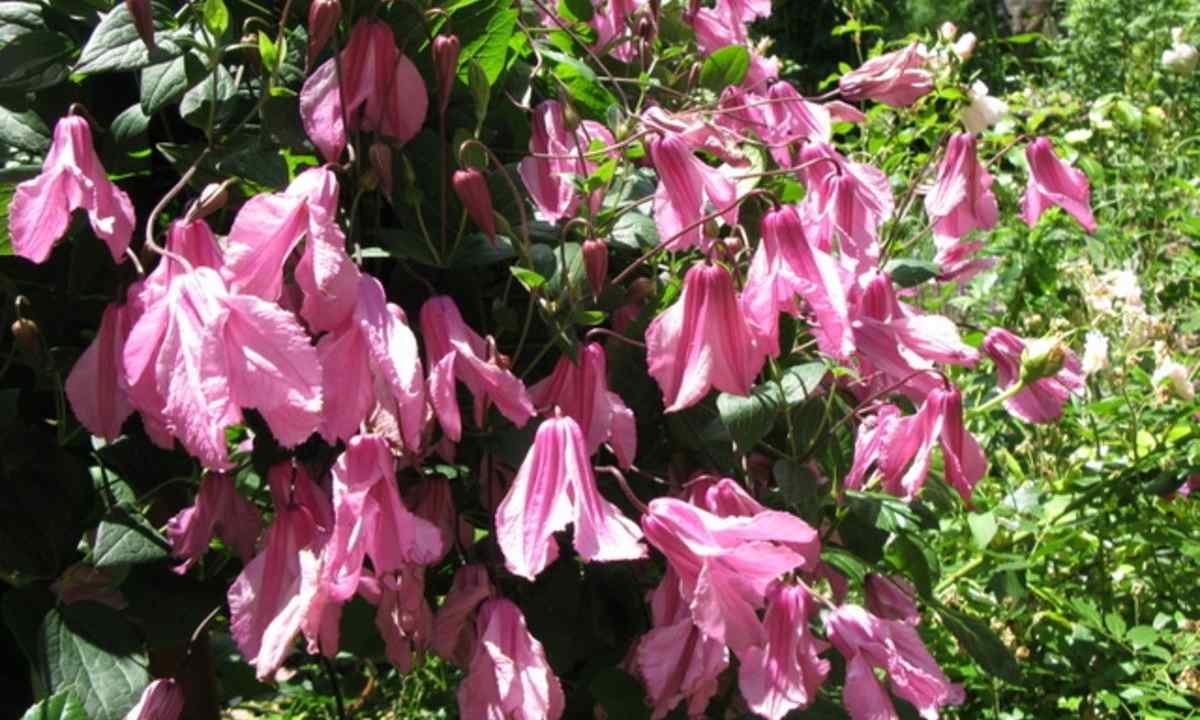Cutting and the shelter – important stages in the course of preparation of clematises for winter. They are necessary for plant for health and magnificent blossoming next year. Each group of clematises has rules of cutting.
When carry out cutting of clematises
You carry out cutting of clematis in the sanitary purposes throughout all summer: delete sick and dry escapes. Delete weak and thin branches in the spring to adjust growth of plant and to make bush it is abundant blossoming.
Pay to autumn cutting special attention. You carry out it before the shelter of bushes for the winter. Postpone works if on the street the warm weather was established. To clematises easy October frosts are not terrible – they only temper bushes. Start cutting approximately in November when steady frosts come.
If to make it earlier while there is heat, at clematis inactive kidneys can start in growth. The growing escapes can be not seen from the earth, but they very gentle, and in winter time will just freeze. So far clematis green, postpone cutting and the shelter.
How competently to cut off clematises that they magnificently blossomed
From that on what lashes of year the clematis stuffs up kidneys, its versions are conditionally divided into three groups. At each of them – the rules of cutting.
The first group
The early-flowering clematises (frost-resistant, melkotsvetny) forming kidneys on branches of previous year have entered it. They do not need autumn cutting as this action is relevant to them in May-June, i.e. on the end of blossoming. Then plants have time for otrashchivaniye of escapes and underlay of kidneys. In the fall just adjust bushes on height and cut off the sick, sickly and dried-up branches. If you live in the region with rather soft winters, can not remove them on wintering from lane. They without problems will pad down also on it.
The second group
Thermophilic hybrids of early blossoming with large flowers enter it. They please with blossoming twice during the season: in May-June and July-August. After spring blossoming of plant increase the long repeatedly blossoming lashes. Such clematises form kidneys both on short last year's escapes, and on new. Cut off such types poorly, approximately on half or third of height, leaving 1-1.5 m of lashes from the earth. Before cutting examine bushes regarding availability of kidneys in sheet bosoms. At their availability leave meter escapes. At very young clematises usually such does not happen therefore safely cut off well.
The third group
Includes all variations of grassy grades of late blossoming and the large-flowered hybrids giving flowers on lashes of the current year. It is group the simplest in question of cutting. Safely cut off Travyansty clematises at the roots, and large-flowered – up to the height of 20-25 cm, leaving 2-3 pairs of kidneys.
If you do not know to what type your clematis belongs, truncate it at first at different height: cut off some escapes to 6-10 couples of leaves, and the others – it is low, to the first real leaves. Thanks to the combined cutting the buds will be located on all bush evenly. In case of cutting at identical height blossoming wait for the first time only in the bottom of bush, and the second – above.
As it is correct to warm clematises in the fall
Warming of bushes means their removal from lane. That it was easy to be carried out in the fall, do not twist lash around rails, and tie up plant to support twine, it is desirable on the one hand. At the end of season just remove strings and foliage which holds bush on lane. After that it is released and ready to the shelter.
Remove lashes from support and warm them only in dry weather. Damp bushes can vyprevat under the shelter.
For successful wintering it is important to protect root neck of clematises. Trace that it could not freeze in ice, and then at approach of thaw decay in water. The lion's share of roots of clematis is hidden deeply in the soil where it frosts, and root neck – weak point are not terrible. If it freezes slightly or podopret – all plant will die.
Process neck before wintering in the preventive purposes the Bordeaux liquid or 1% solution of copper vitriol. As an alternative use friable humus or the earth mixed with peat. Fill up with them the place of kushcheniye of clematis. Do it only on the dry soil!
What to cover clematises for the winter with
Each group has the way of warming. Frost-resistant types can be not covered at all, but in the spring they will begin to increase quicker green material if you zasypit their basis the earth or humus in the fall. Do it on the frozen soil.
To the grassy grades which are cut off under the basis build hillock from humus or the earth. From above for reliability throw their cut-off escapes.
Large-flowered clematises also warm humous layer not less than 10 cm, lay fir-tree fir twigs and the cut-off liana stalks. That urytiye was picked up by wind, from above place branches or wooden box.
Fill up early-flowering thermophilic grades with bucket of peat or dry sheet humus, having built hillock. Frame with the cut-off escapes, and from above throw lutrasit or fir twigs. Fix construction by branches or box. In the absence of fir twigs take plastic boxes for fruit. Envelop its lutrasily that inside the air layer was formed. Will not blow off design if to press down it weighty stone.
Keep in mind what clematises demands the easy, but thick winter shelter, it is obligatory with air layers. Do not use heavy soil for charge. Sand is not suitable for these purposes too: on spring it will become heavy and long will be damp.

